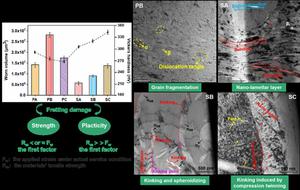Friction ( IF 6.3 ) Pub Date : 2024-06-28 , DOI: 10.1007/s40544-024-0870-y Yanlin Tong , Ke Hua , Haoyang Xie , Yue Cao , Zhuobin Huang , Zhenpeng Liang , Xiaolin Li , Hongxing Wu , Haifeng Wang

|
Fretting wear damage of high-strength titanium fasteners has caused a large number of disastrous accidents. Traditionally, it is believed that both high strength and excellent ductility can reduce fretting wear damage. However, whether strength and ductility are contradictory or not and their appropriate matching strategy under the external applied normal stress (Fw) are still confusing problems. Here, by analyzing the subsurface-microstructure deformation mechanism of several samples containing various α precipitate features, for the first time, we design strategies to improve fretting damage resistance under different matching relation between Fw and the tensile strength of materials (Rm). It is found that when Fw is greater than Rm or Fw is nearly equivalent to Rm, the deformation mechanism mainly manifests as serious grain fragmentation of β and αGB constituents. Homogeneous deformation in large areas only reduces damage to a limited extent. It is crucial to improve the strength to resist cracking and wear, but it is of little significance to improve the ductility. However, when Fw is far less than Rm, coordinated deformation ability reflected by ductility plays a more important role. The deformation mechanism mainly manifests as localized deformation of β and αGB constituents (kinking induced by twinning and spheroidizing). A unique composite structure of nano-grained/lamellar layer and localized deformation transition layer reduces fretting damage by five times compared with a single nano-grained layer. Only when the strength is great enough, improving the plasticity can reduce wear. This study can provide a principle for designing fretting damage resistant alloys.
中文翻译:

高强度钛合金微动过程中的亚表面变形机制以及强塑性与微动磨损性能之间的相互作用关系
高强度钛紧固件的微动磨损损伤已造成大量灾难性事故。传统上认为高强度和优异的延展性都可以减少微动磨损损坏。然而,强度和延性是否矛盾以及它们在外加法向应力(F w )下的适当匹配策略仍然是令人困惑的问题。在此,通过分析含有不同α析出特征的多个样品的亚表面显微组织变形机制,我们首次设计了在F w 与抗拉强度之间不同匹配关系下提高抗微动损伤性能的策略。材料(R m )。发现当F w 大于R m 或F w 与R m 接近时,变形机制主要是表现为β、α GB 成分晶粒破碎严重。大面积的均匀变形只能有限程度地减少损坏。提高抗裂、抗磨损强度至关重要,但提高延展性意义不大。但当F w 远小于R m 时,延性所体现的协调变形能力发挥着更重要的作用。变形机制主要表现为β和α GB 成分的局部变形(孪晶和球化引起的扭结)。纳米晶/层状层和局部变形过渡层的独特复合结构比单个纳米晶层减少了五倍的微动损伤。只有当强度足够大时,提高塑性才能减少磨损。 这项研究可以为设计抗微动损伤合金提供原则。






























 京公网安备 11010802027423号
京公网安备 11010802027423号